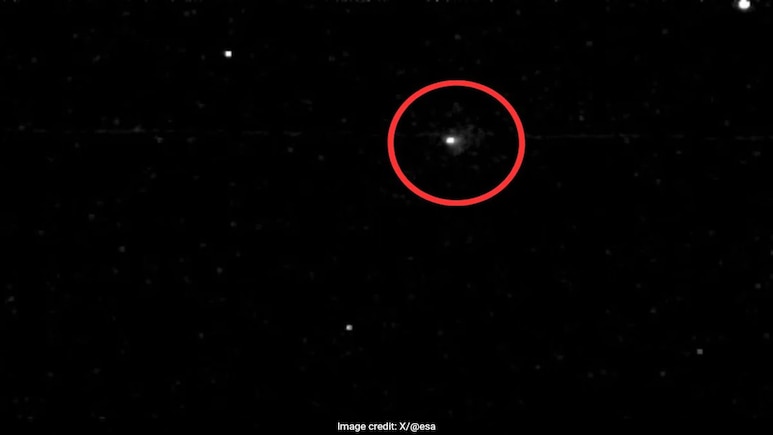
- ESA captured images of interstellar comet 3I/ATLAS flying past Mars on October 3
- 3I/ATLAS is the third known interstellar object to enter the solar system
- The comet travels at 210,000 km/h, not bound by the Sun's gravity
The European Space Agency (ESA) has captured some incredible images of the interstellar comet 3I/ATLAS when it flew past Mars on October 3. The comet, which originated from outside our solar system, was observed by ESA's ExoMars Trace Gas Orbiter (TGO) and Mars Express spacecraft.
NASA quickly shared images of 3I/ATLAS captured by its Perseverance rover on the Martian surface. However, ESA had remained silent. But now, the space agency has finally shared images. One user on X wrote, "ESA Finally Releases Images of 3I/ATLAS. After days of silence, ESA finally broke the blackout."
ExoMars TGO captured a series of images with its Colour and Stereo Surface Imaging System (CaSSIS). A slightly fuzzy white dot in the image is basically the centre of the comet, comprising its icy-rocky nucleus and its surrounding coma. While Mars Express's attempts were less successful due to the comet's faintness.
☄️ #3I/ATLAS comet update!
— European Space Agency (@esa) October 7, 2025
On 3 October, our ExoMars Trace Gas Orbiter (TGO) turned its eyes towards interstellar comet 3I/ATLAS as it passed close to Mars.
Together with Mars Express, ExoMars TGO had the closest view of the comet of all of our spacecraft. It looked towards the… pic.twitter.com/HJE1CeaEwq
What Do We Know About 3I/ATLAS?
The space agencies previously revealed that 3I/ATLAS is the third known interstellar object to enter our solar system, following 1I/'Oumuamua and 2I/Borisov. The comet is travelling at a staggering 130,000 miles per hour (210,000 km/h), indicating it's not gravitationally bound to our Sun.
Some research suggests 3I/ATLAS might have originated from the Milky Way's thin disk and could be over seven billion years old.
Coma Was "Clearly Visible"
In the latest update, the space agency revealed that the coma, measuring a few thousand kilometres across, was clearly visible. The comet will reach its closest point to the Sun on October 29, 2025, at about 1.36 astronomical units (AU) from the Sun. As it gets closer to the Sun, the coma is created.
"The Sun's heat and radiation is bringing the comet to life, causing it to release gas and dust, which collects as this halo surrounding the nucleus," ESA noted.
CaSSIS could not distinguish the nucleus from the coma, because 3I/ATLAS was too far away. Nick Thomas, Principal Investigator of the CaSSIS camera, explains, "This was a very challenging observation for the instrument. The comet is around 10,000 to 100,000 times fainter than our usual target."
"Absolutely Foreign"
The space agency referred to 3I/ATLAS as a "rare visitor" and said that "these comets are absolutely foreign".
"Every planet, moon, asteroid, comet and lifeform in our Solar System shares a common origin. But interstellar comets are true outsiders, carrying clues about the formation of worlds far beyond our own."
The full size of the coma could not be measured by CaSSIS because the brightness of the dust decreases quickly with distance from the nucleus,' the ESA report shared.
'This means that the coma fades into the noise in the image.'
As quoted in the statement, Colin Wilson, Mars Express and ExoMars project scientist at ESA, said: "Though our Mars orbiters continue to make impressive contributions to Mars science, it's always extra exciting to see them responding to unexpected situations like this one. I look forward to seeing what the data reveals following further analysis."
Is It An Alien Tech?
3I/ATLAS was discovered on July 1 by the Asteroid Terrestrial-impact Last Alert System (ATLAS) at a distance of 675 million kilometres from the Sun.
NASA explained that the object has been categorised as interstellar because of the hyperbolic shape of its orbital path. It does not follow a closed orbital path about the Sun. The space agency has also stated that the comet poses no threat to Earth, and it is simply passing through our solar system and will continue its journey into interstellar space.
However, some experts claim that it's an alien technology. Harvard astrophysicist Avi Loeb is convinced that the object could be an alien craft or probe.
Track Latest News Live on NDTV.com and get news updates from India and around the world

